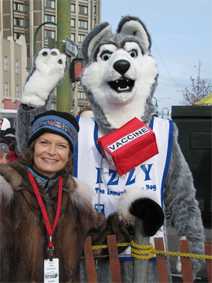A National Vaccine Campaign

Each year, the State of Alaska's Immunization Program teams up with the Iditarod to promote vaccination. This is Iditarod mascot Izzy with Senator Lisa Murkowski at the start of the race. Photo courtesy Doreen Stangel, State of Alaska Immunization Program.
After weighing all possible solutions, Alaska’s Territorial Governor Scott Bone approved a relay of the 20 best mail carrier mushers (sled dog drivers) and 150 dogs along the 674-mile Nenana-to-Nome Trail, a trip that usually took 15 to 20 days.
On January 27, one of the story’s heroes, “Wild” Bill Shannon, picked up the package of antitoxin at the nearest station that could be reached by train and began the journey. Teams of mushers traveled day and night, enduring blizzards and temperatures of 50 degrees below zero, handing off the package to fresh teams. Leonhard Seppala’s team with lead dog, Togo, covered 91 miles —the most dangerous part of the relay — and Gunner Kaasen’s team and lead dog, Balto, finished the lifesaving race, reaching Nome on February 2. This Great Race of Mercy was completed in a record 5 days and 7 hours.
Just two weeks later, after the diphtheria antitoxin was given to the infected children, the quarantine was lifted. At least five children died during the outbreak. However, the collective efforts of hundreds of people to deliver the diphtheria antitoxin prevented the deaths of many other children in Nome and the surrounding area.
The solution to the crisis also became the founding of an event well known today—the Iditarod Trail Sled Dog Race.
A National Vaccine Campaign
In the 1920s, an estimated 100,000 to 200,000 diphtheria cases occurred in the United States each year. Even with treatment, the disease killed as many as 13,000 to 15,000 people every year. The publicity from this outbreak prompted a national campaign in the 1930s to use diphtheria vaccine. It became routinely used by the 1940s after being combined with tetanus and pertussis (whooping cough) vaccines.
In the end, many hundreds of lives in the community in and around Nome were saved because people in Alaska and across the United States worked together with unbridled creativity and drive. And news of this outbreak led to the first national campaign to promote diphtheria vaccination. Today’s high coverage with DTaP in children, which contains diphtheria vaccine, is keeping the United States free from this disease.
- Page last reviewed: March 19, 2014
- Page last updated: March 19, 2014
- Content source:


 ShareCompartir
ShareCompartir